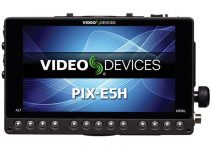As 2018 begins to wind down to a close, it’s interesting to look back at some of the breakthroughs and innovations that were made in the realm of camera technologies throughout the year. All in all, each major camera manufacturer in the field has rolled out a new mirrorless camera that deserves consideration or at least a certain amount of attention. These cameras include (but not limited to) the Sony A7III, Canon EOS R, Fujifilm X-T3, Nikon Z7, and of course, the Blackmagic Pocket Cinema Camera 4K.
With all these options available on the market, it can be pretty overwhelming to pick the right one for you. So, if you’re curious as to how these particular offerings stack up against one another, you might want to take a closer look at the next video produced by Max Yuryev, where he puts all five rivals to the test in a side-by-side video quality comparison.
For these tests, Max focused on comparing the video quality of each device when shooting at 4K, 1080p, as well as evaluating slow motion capabilities while filming at 120fps by utilizing the maximum supported resolution respectively. To ensure a fair comparison, he tried his best to match all camera settings and attempted to use lenses that were similar in terms of sharpness and quality.
For the 4K shootout, the Sony A7III camera produced the best-looking video with excellent image detail and no aliasing. In fact, the image was good enough that when looking at a car’s license plate from afar, you can almost read out the numbers on the plate. Right behind the A7III is the Fujifilm X-T3, wherein its video quality turned out to be comparable to that of the A7III – sharp, minimal aliasing, and natural-looking.
The Blackmagic Pocket Cinema Camera 4K also held up in a similar way in this test with minimal aliasing and a fairly detailed image. The Nikon Z7 had relatively good image detail, however, there is clear evidence of oversharpening when you look at the areas of the image with strong lines.
Lastly, the Canon EOS-R seemed to produce the least appealing video. While the footage may not show a lot of aliasing, the EOS-R lacks image detail and captures 4K footage that is too soft, looking as if it was upscaled from 1080p.
When filming at 1080p, the Fujifilm X-T3 and Blackmagic Pocket Cinema Camera 4K both come out on top in terms of video quality. However, Yuryev believes that the Fujifilm X-T3 produces slightly sharper video over the BMPCC 4K. Following suit with the two cameras is the Sony A7III which also has decent image detail, even though not as sharp as Fujifilm and Blackmagic’s offerings.
Behind the three cameras comes Nikon, which produces a crunchy-looking and over-sharpened images. And finally, as with the previous test, Canon comes out last in regards to image quality. Disappointingly, even while using the full sensor area, the EOS-R’s image still appears soft, over-sharpened as well as looking as if Canon performed a 720p to 1080p upscale.
The final test conducted involved shooting at 120fps with each camera. The Fujifilm X-T3 is the winner in this scenario, with relatively sharp image details. However, because the X-T3 must further crop into its APS-C when recording at 120fps, this camera will suffer in low light. Also, shooting at 120fps means that you can’t record any audio since the video is conformed into slow motion internally. Thankfully, autofocus capabilities are still enabled when shooting at 120 fps.
Meanwhile, Sony has always been hailed for their excellence in slow motion. With the A7III, you can shoot at full 1080p at 120fps while using the entire area of its full frame sensor. In addition, with the A7III, you can choose to either slow down the video inside the camera or later in post. That being said, you have full access to your camera’s autofocus capabilities and the ability to record audio when shooting at such a high frame rate.
Blackmagic and Nikon’s own respective integration with 120fps seems adequate. However, there are some limitations you should keep in mind. For instance, you will be forced to crop into the sensor on both cameras, thus limiting your field of view. In addition, you will notice some softer images coming from the BMPCC 4K, while the Nikon Z7 shows signs of oversharpening.
Unfortunately, as with the other tests featured in the video, Canon’s EOS-R camera provided the most limited shooting experience. With the EOS-R, you can record 120 fps footage at 720p resolution only, with no audio recording or autofocus available in this mode. These limits make it extremely difficult for slow motion videographers to adequately capture high-quality footage.
Looking back at all these cameras, there are several conclusions that can be made right off the bat. While Sony continues to dominate the mirrorless market which they’ve founded, competitors like Blackmagic and Fujifilm are quickly garnering pace with cameras that are equally as good as Sony’s in terms of video, all for a relatively lower price.
Nikon, who has joined the mirrorless camera market relatively late, has started to get a hold of the film industry’s attention with their first film-focused mirrorless camera. While they’ve still got a lot to learn, their Z7 is a solid contender, considering it’s their first venture into mirrorless videography.
Canon, however, seems to have a misstep with their EOS-R. For a manufacturer so well known for their DSLRs and EOS cinema camera lineup, it’s somewhat shameful to see the company struggle with their first mirrorless, bundled with limitations and lackluster image quality. We can only hope that the Japanese behemoth will listen to the needs and desires of EOS-R costumers, hopefully creating some more significant improvements to the shooting experience in the next iteration of their full frame mirrorless camera lineup.
Ultimately, if you like these tests, make sure to check out the other related videos on Max Yuriev’s YouTube Channel where he compares autofocus capabilities and low light performance of these cameras, thus providing even greater insight for those of you who want to dig deeper into the subject.
[source: Max Yuryev]
Order Links:
- FUJIFILM X-T3 Mirrorless Digital Camera (B&H, Amazon)
- Canon EOS R Mirrorless Digital Camera (B&H, Amazon)
- Sony Alpha a7 III Mirrorless Digital Camera (B&H, Amazon)
- Nikon Z7 Mirrorless Digital Camera (B&H, Amazon)
- Blackmagic Design Pocket Cinema Camera 4K (B&H, Amazon)
Disclaimer: As an Amazon Associate partner and participant in B&H and Adorama Affiliate programmes, we earn a small comission from each purchase made through the affiliate links listed above at no additional cost to you.



